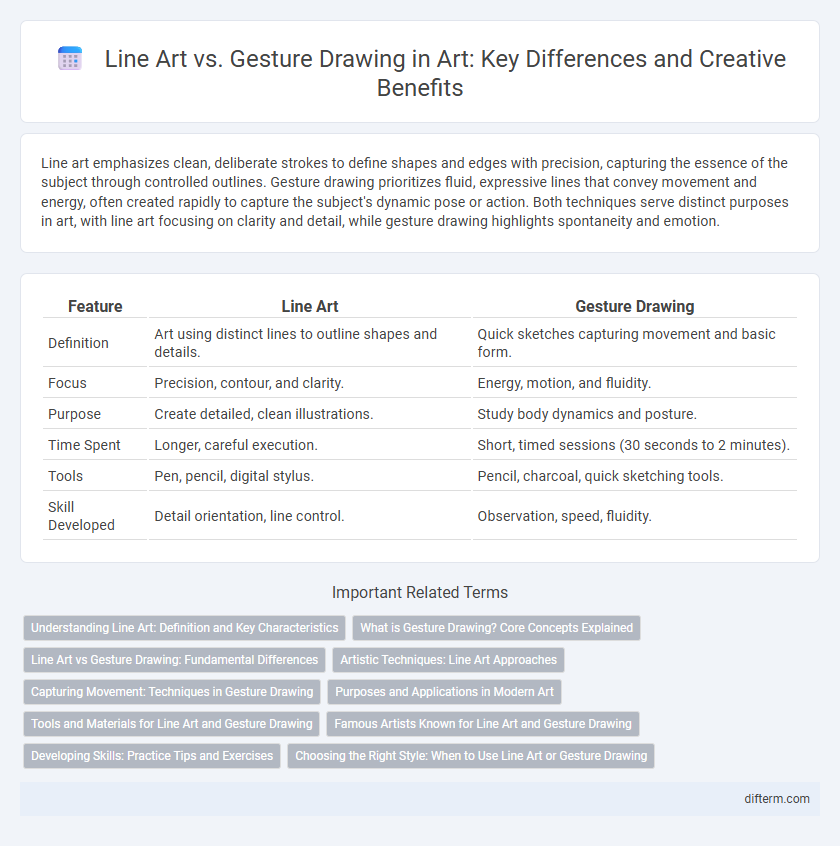Line art emphasizes clean, deliberate strokes to define shapes and edges with precision, capturing the essence of the subject through controlled outlines. Gesture drawing prioritizes fluid, expressive lines that convey movement and energy, often created rapidly to capture the subject's dynamic pose or action. Both techniques serve distinct purposes in art, with line art focusing on clarity and detail, while gesture drawing highlights spontaneity and emotion.
Table of Comparison
| Feature | Line Art | Gesture Drawing |
|---|---|---|
| Definition | Art using distinct lines to outline shapes and details. | Quick sketches capturing movement and basic form. |
| Focus | Precision, contour, and clarity. | Energy, motion, and fluidity. |
| Purpose | Create detailed, clean illustrations. | Study body dynamics and posture. |
| Time Spent | Longer, careful execution. | Short, timed sessions (30 seconds to 2 minutes). |
| Tools | Pen, pencil, digital stylus. | Pencil, charcoal, quick sketching tools. |
| Skill Developed | Detail orientation, line control. | Observation, speed, fluidity. |
Understanding Line Art: Definition and Key Characteristics
Line art defines artwork composed exclusively of distinct lines without shading or gradient to represent shapes and details, emphasizing contours and edges. Key characteristics include clarity, simplicity, and precision in rendering forms, often using varying line weights to convey depth and movement. Unlike gesture drawing, which captures motion through loose, dynamic strokes, line art prioritizes structure and crispness to depict static subjects with clean, deliberate lines.
What is Gesture Drawing? Core Concepts Explained
Gesture drawing captures the essence and movement of a subject using quick, expressive lines to convey dynamic poses and energy. It focuses on the overall form and action rather than intricate details, prioritizing fluidity and motion to represent the figure's rhythm and proportions. This technique serves as a foundational practice for artists to understand body mechanics and enhance spontaneity in their artwork.
Line Art vs Gesture Drawing: Fundamental Differences
Line art emphasizes precise, clean lines to define shapes and contours, creating clear and detailed illustrations. Gesture drawing captures the essence and movement of a subject with quick, fluid strokes, prioritizing energy and flow over detail. The fundamental difference lies in line art's focus on controlled, deliberate lines versus gesture drawing's spontaneous, expressive marks.
Artistic Techniques: Line Art Approaches
Line art emphasizes precise, clean lines to define shapes and contours, often focusing on clarity and structure. Gesture drawing captures the essence and movement of a subject through quick, fluid strokes, prioritizing dynamism over detail. Both techniques serve different artistic purposes, with line art excelling in detailed representation and gesture drawing enhancing expressive motion.
Capturing Movement: Techniques in Gesture Drawing
Gesture drawing employs fluid, quick strokes to capture the essence of movement and the energy of a subject, contrasting with the precise, deliberate lines typical in line art. Techniques such as continuous line drawing, focusing on the flow of the body, and emphasizing dynamic poses enable artists to convey motion and spontaneity effectively. This approach is essential for animators and illustrators aiming to depict lifelike action and expressiveness in their work.
Purposes and Applications in Modern Art
Line art emphasizes precise, clean outlines to define shapes and details, making it ideal for graphic design, comics, and digital illustrations where clarity and structure are paramount. Gesture drawing captures movement and form through quick, expressive strokes, serving as a foundational practice in animation, life drawing, and modern art studies to convey energy and emotion. Both techniques are essential in contemporary art; line art supports detailed narratives while gesture drawing enhances dynamism and spontaneity in creative works.
Tools and Materials for Line Art and Gesture Drawing
Line art typically requires precise tools such as fine-tip pens, technical pencils, and smooth paper to achieve clean, controlled lines that emphasize contour and detail. Gesture drawing utilizes softer tools like charcoal sticks, graphite pencils, or broad markers on textured sketch pads, allowing for quick, expressive strokes that capture movement and form. Both techniques rely on different material qualities to support their distinct artistic goals--precision for line art and fluidity for gesture drawing.
Famous Artists Known for Line Art and Gesture Drawing
Famous artists known for line art include Pablo Picasso and Egon Schiele, who utilized bold, expressive lines to convey emotion and form. Gesture drawing experts like Leonardo da Vinci and Henri Matisse captured movement and fluidity through quick, dynamic sketches that emphasize the essence of the subject. These contrasting approaches showcase the power of line in both deliberate detail and spontaneous expression within artistic practice.
Developing Skills: Practice Tips and Exercises
Line art sharpens precision and control by emphasizing clean, deliberate strokes that define contours and shapes, enhancing hand-eye coordination through repetitive practice. Gesture drawing accelerates understanding of movement and fluidity by capturing the essence and energy of poses in short, timed sketches, encouraging spontaneity and dynamic observation. Combining both techniques in exercises, such as alternating between quick gesture warm-ups and focused line drawings, cultivates a balanced skill set essential for artistic development.
Choosing the Right Style: When to Use Line Art or Gesture Drawing
Line art excels in capturing precise details and defined contours, making it ideal for architectural sketches, character design, and technical illustrations. Gesture drawing prioritizes movement and fluidity, perfectly suited for dynamic poses, quick studies, and exploring emotion or action. Selecting the right style depends on the intended expression--choose line art for clarity and structure, gesture drawing for energy and spontaneity.
Line art vs Gesture drawing Infographic

 difterm.com
difterm.com